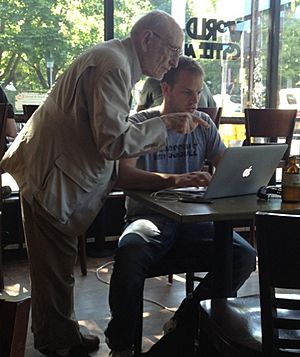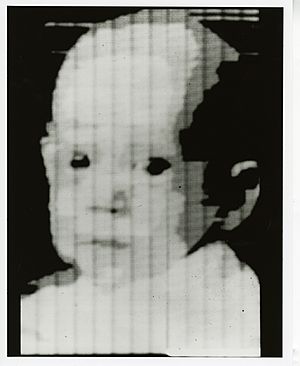Russell Kirsch facts for kids
Quick facts for kids
Russell Kirsch
|
|
|---|---|

Russell Kirsch in Portland, Oregon with Joel Runyon
|
|
| Born | June 20, 1929 Manhattan, New York, U.S.
|
| Died | August 11, 2020 (aged 91) Portland, Oregon, U.S.
|
| Education | Bronx High School of Science (1946), BEE New York University (1950), SM Harvard University (1952), American University, Massachusetts Institute of Technology |
| Occupation | Computer scientist |
| Known for | First digital image scanner |
| Spouse(s) | Joan (née Levin) Kirsch |
| Children | Walden Kirsch (KGW reporter), 3 other children |
Russell A. Kirsch (born June 20, 1929 – died August 11, 2020) was an American engineer. He worked at the National Bureau of Standards, which is now called the National Institute of Standards and Technology. Kirsch is famous for creating the first digital image scanner. He used it to scan the world's first digital photograph, which was a picture of his baby son.
Contents
Russell Kirsch's Life
Early Life and Education
Russell Kirsch was born in Manhattan, New York, on June 20, 1929. His parents had moved to the U.S. from Russia and Hungary. He went to the Bronx High School of Science and finished in 1946. After high school, he continued his studies at New York University, Harvard University, and the Massachusetts Institute of Technology.
Family Life
Kirsch was married to Joan (née Levin) Kirsch for 65 years. They had four children together: Walden, Peter, Lindsey, and Kara. He spent most of his working life in Washington, D.C., where he worked for the National Institute of Standards and Technology for almost 50 years. After he retired in 2001, he moved to Portland, Oregon.
Russell Kirsch passed away at his home in Portland on August 11, 2020, at the age of 91. He had been dealing with dementia before his death.
Russell Kirsch's Career
In 1951, Russell Kirsch joined the National Bureau of Standards. He was part of a team that worked with the SEAC computer. SEAC was one of the first computers in the U.S. that could store programs, starting in 1950.
Inventing the Digital Image Scanner
In 1957, Kirsch's team created a digital image scanner. This machine could "trace changes in brightness" across the surface of photographs. They used it to make the very first digital scans. One of the first pictures they scanned was of Kirsch's three-month-old son. This image had only 30,976 pixels, arranged in a 176 by 176 grid. It was a small picture, about 5 cm by 5 cm (2 inches by 2 inches).
The first scans were simple black and white, with no shades of gray. But by scanning the same picture several times with different settings, they could also get grayscale information. This meant they could capture shades between black and white. They used the computer to find lines in images, count objects, read letters and numbers, and show pictures on a screen. Kirsch also suggested a method called the Kirsch operator to find edges in images.
Later Work
Later in his life, Kirsch became the research director for the Sturvil Corporation. He also worked as an advisory editor for the Institute of Electrical and Electronics Engineers (IEEE). He was an editor for a journal called Languages of Design.
Major Accomplishments
In 2003, Life magazine named Kirsch's scanned picture of his son one of the "100 Photographs That Changed the World." This was because of its huge importance in the development of digital photography. The original digital image is now kept at the Portland Art Museum.
Even though Kirsch didn't work for NASA, his invention helped create technology that was very important for space exploration. This included the Apollo Moon landing. His research also led to medical breakthroughs, such as the CAT scan, which was developed by Sir Godfrey Hounsfield.
See also
 In Spanish: Russell A. Kirsch para niños
In Spanish: Russell A. Kirsch para niños
- Digitization


